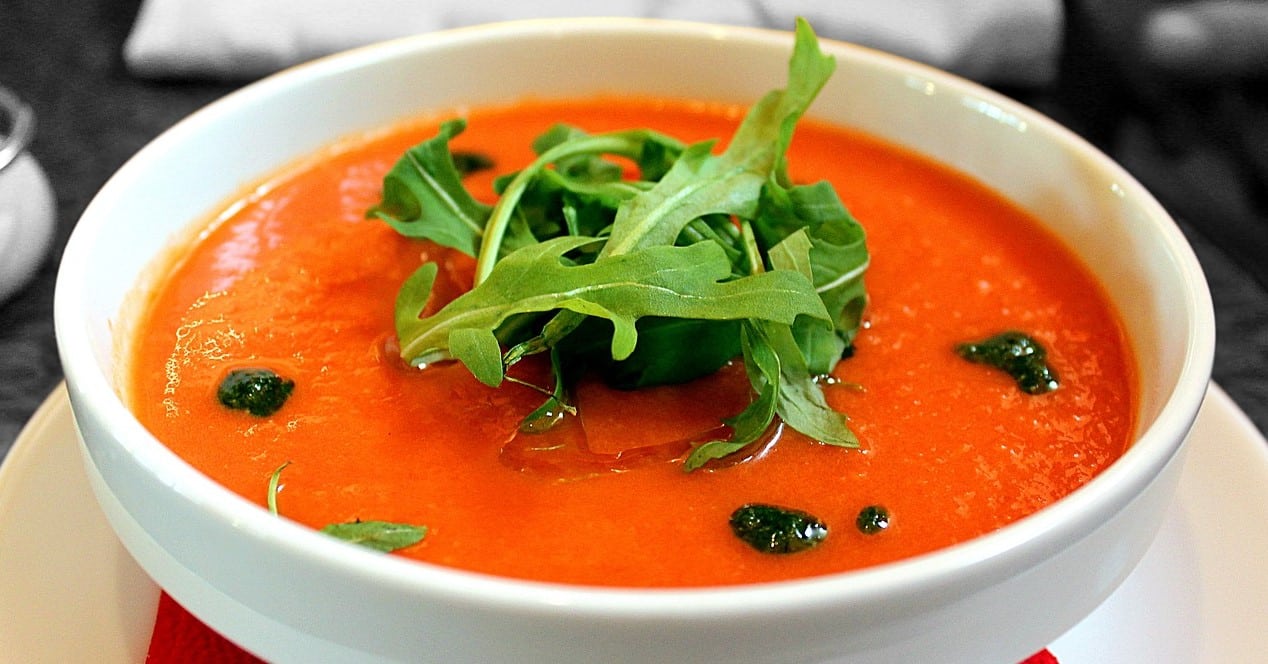
Gazpacho has existed in our culinary tradition for several decades, although currently different recipes have emerged. Below you will find a classic Andalusian gazpacho, simple and with all the nutrients of all the ingredients. Also, even if it has bread, we can remove it from the recipe and that would be a gazpacho suitable for celiacs.
Making a gazpacho is like gathering almost all the nutrients our body needs in a day in a single glass. A simple, quick and flavorful recipe. In addition, we can play with it at will, even going so far as to make it soup, make it sauce or make it cream.
Surely we have never tried dressing a salad with gazpacho, because we have already jumped on the idea, now we just need to learn how to make gazpacho and dress our salad with that sauce instead of using ultra-processed sauces loaded with unnecessary and unhealthy ingredients.
Today's recipe is quick and very healthy, we only need a blender or a Thermomix (or similar) and a good knife to cut the ingredients. Throughout the text we will say what other utensils we need, especially for the conservation of this recipe.
Why is gazpacho healthy?
It is a very healthy meal or first course for several reasons and they are the ones that we are going to tell you next. Gazpacho, it is usually better to make it homemade than to buy it, but it is true that there are already many very healthy options on the market and that they only have the strictly necessary ingredients.
Although, as has become evident, it is better that we prepare it at home. Our recipe is very healthy mainly for 2 reasons. The first is that a portion of this Andalusian gazpacho recipe, it only has 160 kilocalories, and the second reason is that we have only used natural and fresh ingredients.
There are no extra and unnecessary ingredients. In addition, the decoration is left to the choice of each reader. We can use arugula, ham, black olives, chopped tomatoes, cucumber slices, fish, meat, cheese, etc.
When making our recipes, our premises are the use of healthy, fresh, cheap ingredients that are easily found in the supermarket.
Can it be done without bread?
Gazpacho can be made in multiple ways, depending on the recipe we choose. If we want it to be fit and low in carbohydrates, we recommend doing it without bread. Better to take advantage of the goodness of sweet tomatoes, olive oil, garlic, cucumber, and bell peppers. If we want to thicken this tomato soup, we can add carrots or pumpkin. Gazpacho soup is traditionally made without bread, making it a light and healthy dish.
Other popular versions use more red peppers (known as salmorejo) or almonds (known as ajoblanco). Although in those two dishes, bread is usually a main ingredient to make it creamier. However, this fit gazpacho provides very few calories and many vitamins.
What does this gazpacho bring?
The ingredients are all of vegetable origin, as is obvious, apart from salt, extra virgin olive oil and sherry vinegar. As for the vegetables and bread, we can make the combinations we want, in fact, there is watermelon gazpacho, zucchini, beetroot, cucumber, melon, strawberries, etc.
In gazpacho, bread is optional, as it provides some nutrients and helps thicken the cream, but it is not mandatory to use it, especially if there are celiacs among the guests.
In our recipe we have used tomatoes, green pepper, cucumber, onion and garlic. What better way to make us aware of the nutrition bomb which is the homemade Andalusian gazpacho, what a wind all that its ingredients give us. Let's decipher the vitamins and minerals of the main ingredients:
- tomatoes: vitamins A, B1, B2, B3, B6, C, K and E. Among the minerals we find potassium, chlorine, phosphorus, calcium, sulfur, magnesium, sodium, iron, copper, zinc, iodine, cobalt, manganese, chromium, nickel , etc.
- Onion: it has vitamins A, B6, C and E. The minerals they provide are iron, potassium, phosphorus, selenium, magnesium and calcium.
- Pepper: vitamins A, B1, B2, B3. B6, B9, C and E. Apart from minerals such as potassium, phosphorus, magnesium and calcium.
- Cucumber: it has vitamin A, group B like B9 and C. The minerals are calcium, iron, magnesium, phosphorus, potassium and zinc.
- Garlic: the main vitamins are A, B and C. As for minerals we have iodine, phosphorus and potassium.

Tips to improve the recipe
It is a very simple recipe in which we only have to mix and grind everything very well, but it is still this advantageous situation where you do not have to bother too much, drawbacks can arise.
For example, to achieve a deep red color, instead of a salmon-like orange color, you have to grind the ingredients little by little, instead of all at once. In the first batch we must beat the ripe tomatoes and in the second batch the rest of the ingredients including salt and vinegar. Next we mix the tomato from the first batch that we had reserved separately with what we have just crushed and in this way we will achieve that when we beat everything again, we have a brighter red.
Another tip is remove the seeds from the peppers and cucumber. It is taken for granted that those of the peppers are going to be eliminated, but we remember it just in case.
Finally, a very important piece of advice, although it is optional, is to let the Andalusian gazpacho rest for at least 5 or 6 hours. If we wait a day, its flavor will be more intense than if we eat it just as we finish preparing it. Also, by keeping it in the fridge for 24 hours, the result will be fresh and very tasty.
Substitutions
The thing about gazpacho is that it is quite versatile. Many people skip the cucumber, and others sometimes use red bell pepper instead of the more traditional green bell pepper. The traditional recipe usually thickens the gazpacho with a piece of stale bread or even with carrots, but it is not necessary if we want to reduce calories or make it less thick.
On the other hand, olive oil also generates debate. Some people use more or less olive oil, just a few tablespoons, and others add more cold water at the end to make the texture lighter and waterier. It is best to experiment until you find what you like best. For example, there are more modern versions of gazpacho, such as the green gazpacho and the watermelon gazpacho.
How to keep it?
This recipe is easy to keep maximum 3 days in the refrigerator. The most important thing is to use the right container with a tight-fitting lid, apart from not putting it on the fridge door, since there are big temperature changes there that can last several seconds and cause the food to spoil sooner.
Before storing it in the fridge, we must empty the contents into a clean and dry glass container with a tight lid. Under no circumstances should we eat directly from that container, unless we are going to eat it from you. If we are going to serve, we must use a clean utensil, since any other food can contaminate the gazpacho and spoil it.
The issue of the hermetic lid is not only so that oxygen does not enter and the bacteria are able to survive, but also because if we use silver foil, napkins, plastic wrap or similar (and even without a lid) the gazpacho can be contaminated with any liquid that is in the fridge, a food in a state of putrefaction, ourselves when handling things in the fridge, etc.
Gazpacho will last 4-5 days if stored in the refrigerator in an airtight container. Also, you can freeze, although thawed gazpacho will always be slightly different from the fresh version in both taste and appearance.
How is it taken?
On the other hand, it is believed that gazpacho originates from the south of Spain, where temperatures in summer can reach 48°C. A cold soup is necessary to stay hydrated and cool during such hot weather. That being said, prior to refrigeration, the gazpacho would have been served at room temperature (but never warm or hot).
The gazpacho can be enjoyed at any time of the day. Many people start the day with a glass of cold gazpacho (especially when they feel unwell or tired from the heat). It is usually eaten as an appetizer or entree for lunch or dinner, served in a glass or small bowl with garnishes.
recommended coverage
With such a simple puree soup, ingredients are a must. You can really add any combination to the gazpacho:
- Homemade Croutons – Easy to make with any leftover bread you have on hand.
- Fresh herbs: basil, thyme, oregano, rosemary, and/or chives are some of our favorites.
- Freshly ground black pepper: always a must.
- Olive oil: an extra drizzle on top is traditional in Spain.
- Spanish ham and chopped hard-boiled eggs: These toppings are traditional with salmorejo, but are also popular with gazpacho in southern Spain.
Or, probably the most common is to sprinkle on top some of the chopped vegetables left over from the gazpacho (such as tomato, green pepper, onion or cucumber).
Disadvantages of gazpacho
A drawback may be its very fine texture and extremely aggressive vinegar taste. To make a successful gazpacho, the most important advice is to be careful with the vinegar. It is absolutely essential to use high-quality soft wine or sherry vinegar. Cider vinegar is also a good choice because it is always less aggressive.
But even when we use a mild vinegar, we will add it sparingly. A gazpacho should have an acid taste but never an overwhelming presence of vinegar. The vast majority of cooks, both professional and amateur, are inclined to use too much vinegar.
On the other hand, although the gazpacho is full of vegetables, it also contains a good amount of olive oil and the calories it takes. If it weren't for those calories, the gazpacho would not have sustained an Andalusian peasant during his long working day. Of course, we can make gazpacho without olive oil, but it would not be an authentic one. When we are making regional Spanish dishes, we should never settle for a light version.